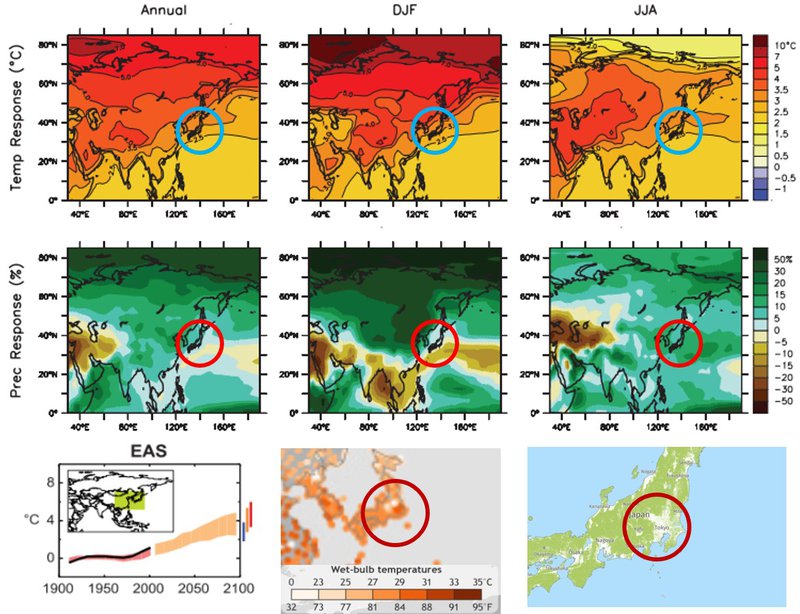Tokyo region: location
Tokyo
(The map here shows circles of 20, 40 & 60km radius, a rough approximation to the gravity field).
Tokyo region: overview
Climate Hazard
(World Bank data profile for Tokyo)
Extreme heat - Medium
Wildfire - High
Water scarcity - Low
River flood - High
Urban flood - High
Coastal flood - High
Cyclone - No data
Tsunami - High
Landslide - High
Earthquake - High
Volcano - High
Spatial mapping
The Peri-cene takes a practical approach to the complexity of peri-urban-climate interactions. The base-maps here build on the JRC-GHSL (Global Human Settlements Layer) system of urban mapping with 1km2 cells - http://ghsl.jrc.ec.europa.eu. In this way the peri-urban definition and mapping is not a final answer, but the start of discussion. For more on the questions of ‘where is the periurban’ and ‘how is it changing’ see the D3-1 report.
Population density map
This shows 3 population density bands: 0-50, 50-125, and 125-300 persons/km2: (transparent for open land, and then green and yellow cells). These are in different proximities to the main urban centres, for the moment defined by distances (from the urban centre), of 0-20, 20-40, and 40-60 km: titled ‘near-urban: further-urban: ex-urban / peri-rural’.

Population change map
Content coming soon.
Climate projections: river flooding
Including river flooding and related extreme events, this is a ‘reasonable worst case scenario’ for 2080, with reduced policy and pessimistic modelling. This is based on the mapping from https://www.wri.org/resources/maps/aqueduct-global-flood-analyzer.

Climate projections: coastal flooding
Including sea level rise, tidal and storm surge effects, this is a ‘reasonable worst case scenario’ for 2080, assuming reduced climate change policy, and ‘pessimistic’ modelling. This is based on the mapping from www.climate-central.org

Climate projections: temperature effects
(Top & middle parts include):
- temperature uplift and precipitation uplift, projected with the central ‘A1B’ scenario, for 2080-2100. Source: IPCC - AR4 - WG1 - Chapter 11-1 - https://www.ipcc.ch/site/assets/uploads/2018/02/ar4-wg1-chapter11-1.pdf
(Lower part includes):
- Comparison of projected temperature rise under B1, A1B, A2 emissions scenarios: Source - IPCC - AR4 - WG1 - Chapter 11-1
- Peak wet bulb temperatures 1979-2017: (note TW of 30-350 can be lethal). Source : https://research.noaa.gov/article/ArtMID/587/ArticleID/2621/Dangerous-humid-heat-extremes-occurring-decades-before-expected
- Fire (2020 summer period) & forest cover maps (>30% canopy cover): Source https://www.globalforestwatch.org

